Momordika is an exotic thermophilic vegetable that can be successfully grown in a greenhouse. It has a lot of useful properties, it can stop the aging of the body and treat the immunodeficiency virus, it has long been used in Asian cuisine to prepare delicious dishes. How to grow this wonderful vegetable on your site, read the article.
Material Content:
Momordica - what kind of plant?
Momordica is a liana, a plant from the Pumpkin family. In central Russia, it is grown in a greenhouse, in the south of the country it grows well in open ground.
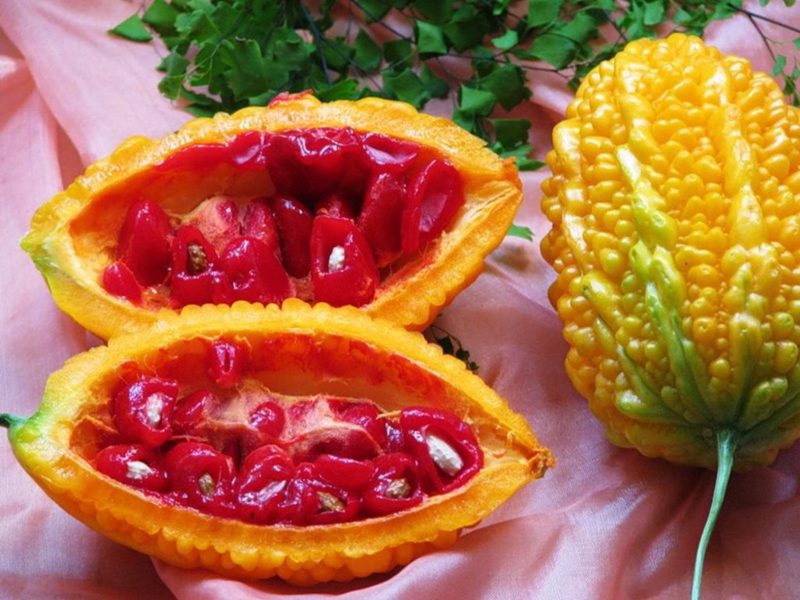
The plant is popularly called rejuvenating berry. Indeed, the pulp contains substances (antioxidants) that inhibit the aging of the body and the development of cancer cells.
Eat green and ripe fruits. In appearance, they differ. In a green form, the mammoths are stewed. The bitter taste is removed in the same way as eggplant - it is salted, and then washed or soaked in salt water.

Momordica is also called rabid melon; its fruits, when ripe, have a bright orange or yellow color. They are covered with prickly outgrowths or tubercles. When ripe, the fruits crack and bright red seeds in a juicy mouth-watering shell resembling pomegranate seeds are visible inside. It was for them that the vegetable received the name - Indian pomegranate.
Fruits and seeds give people weakened by the disease, they help restore strength. For those with diabetes, ripe sweet seeds lower their blood sugar. Momordica speeds up the metabolism in the body, it is useful for people who want to lose weight. Its flesh removes "bad" cholesterol and toxins from the body.
Green and ripe fruits are considered healing. The most valuable is the sweet shell of ripened seeds.From the leaves of the plant make medicinal tinctures that help with hypertension, cough.
The chemical composition and calorie content of momordiki
They use the stewed green fruits of momordiki, make stews, and stuff like peppers. They also eat ripe, waiting for the sweet, red seeds to resemble persimmons or sweets to ripen. If the fruit is overripe and cracked, the seeds lose their wonderful sweet taste.
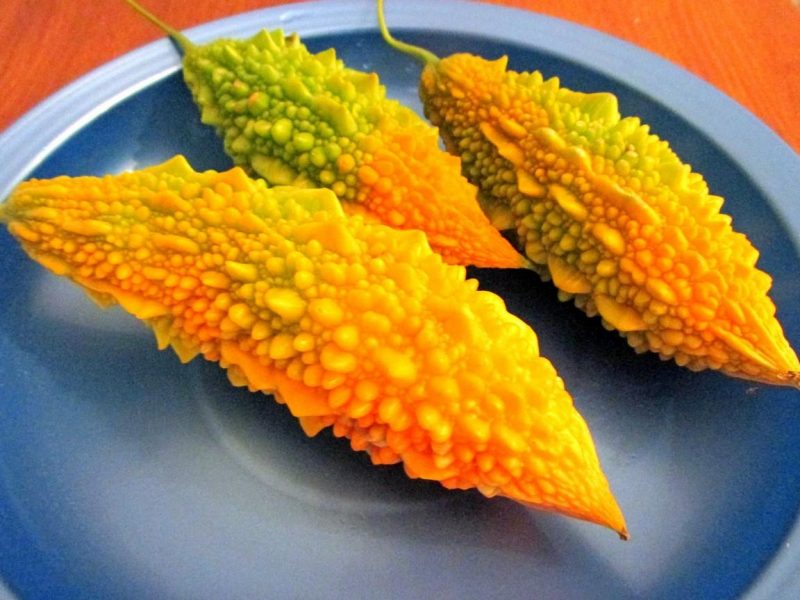
The calorie content of 100 g of momordiki pulp is about 20 kcal, it includes a large amount of water (80%), dietary fiber, carbohydrates and proteins. Useful qualities are determined by the presence of a large number of vitamins and mineral salts. The fruit of momordica harania contains twice as much calcium as in spinach and twice as much potassium as in banana.
Varieties and varieties
In nature, there are about 20 species of momordica that grow in the tropical and subtropical regions of Australia, Africa and Asia.
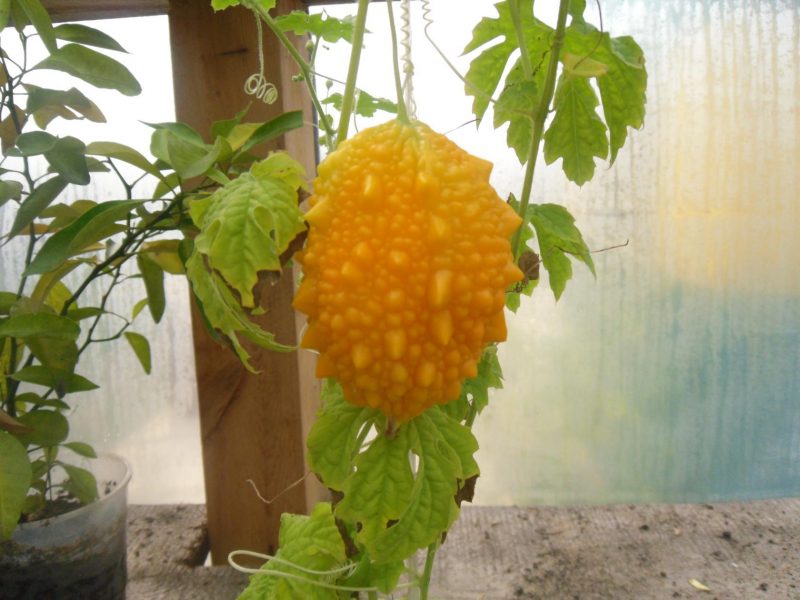
In culture, 3 species are grown:
- momordica harania or Chinese bitter gourd is a vegetable popular in Asia, its fruits are useful, they have an oblong shape, are covered with spikes, they are eaten fresh and stewed, ripe red seeds are sweet and tasty;
- Kokhinkhinsky momordica or gak - is grown in countries of Southeast Asia and greenhouses of Europe, the fruits are ellipsoidal, round, about 10 cm in diameter, with outgrowths in the form of papillae, the seeds are large, flat, smell unpleasant;
- Momordica dioecious - cultivated in India, the fruits are shaped like a lemon covered with thorns, they are boiled, stewed, fried with meat or fish.
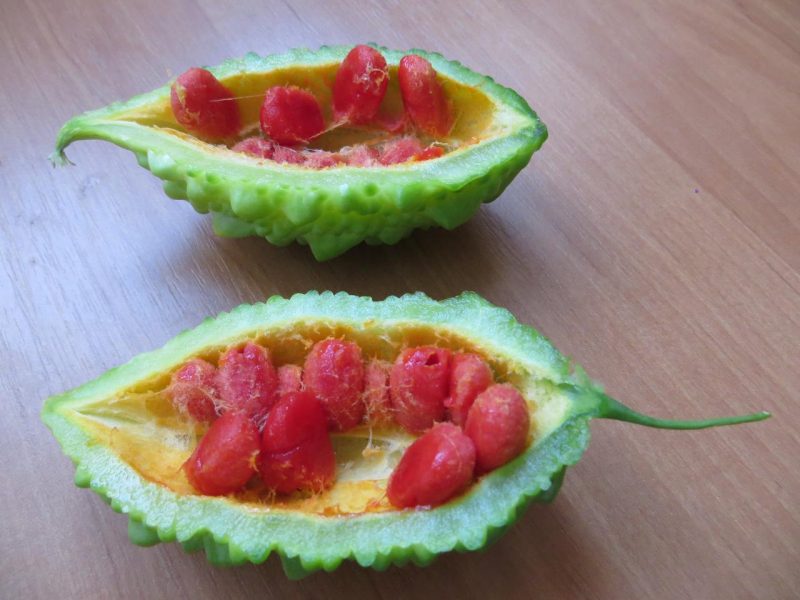
For therapeutic purposes, Kokhinkhinsky momordica is used, oil with a high carotene content is obtained from the seed coat. It helps to heal wounds and skin diseases, boosts immunity, stimulates mental activity, soothes, and helps restore vision. For medical purposes, other parts are also used - leaves, root. The pulp of fruits is used to make a New Year's Vietnamese pie.
Growing Features
The heat-loving momordica, which is grown through seedlings, grows better in greenhouses. Before planting, the seeds are soaked in wet gauze for 3 or 4 hours.
When buying seeds, you need to pay attention to the shelf life of the batch. Expired seeds may not sprout.
Each seed is planted in a separate pot, because the seedlings do not tolerate the transplant, cover with film or glass, and wait for seedlings. Then put on the brightest place. When shoots appear, the shelter is removed. If it is cloudy or short daylight, the seedlings are illuminated with fluorescent lamps.
Mammordiki seedlings are also prepared as with cucumbers, it should not outgrow. This plant is thermophilic, but you can’t pull it with a transplant to a permanent place in a greenhouse or open ground. In the room, the seedlings suffer from a lack of light, stretch, this will be reflected in the future on fruiting.
When planting in the soil, you can deepen the seedlings to cotyledon leaves, like all pumpkin leaves. Seedlings are transplanted to a permanent place at the age of 25 days. Bushes are placed at a distance of 60 cm from each other. If the soil is unprepared, humus (0.5 l) and wood ash (1 tbsp.) Are added to each well.
How to care for momordica
Plant care is the same as for cucumbers - it is fed, watered, mulched soil. The leaves are burned until the fruit ripens, like nettles; during work, hands should be protected with gloves.
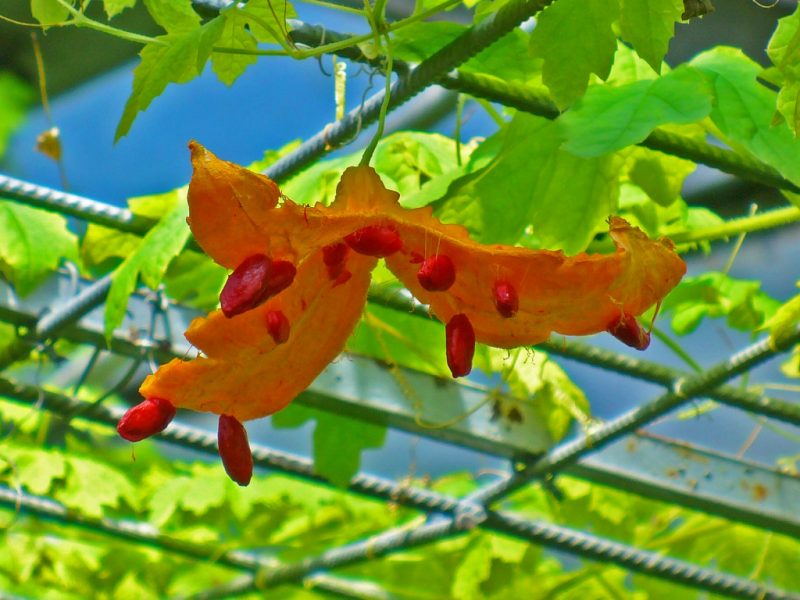
Momordica is a cross-pollinated plant. When planting in a greenhouse, pollinate the flowers with a brush, transferring pollen from one plant to another so that the fruits are tied.
The plant loves moisture, you can’t dry the soil very much, watering should be regular and plentiful. The first time momordica is fed, when flower buds appear, with a complex mineral fertilizer diluted in water. The second top dressing (nitrophosic) is needed after the fruit has set. The third top dressing is carried out 20 days before the end of the harvest.
The stem is lifted onto the trellis, and they are waiting for fruits that ripen in July. They are cut green or when the color changes to yellow. If you miss the moment, the vegetables will crack and become inedible.
In ancient times, Momordic was allowed to eat only by emperors, these unusual fruits were so appreciated. Growing them in your area is an interesting and useful activity.












